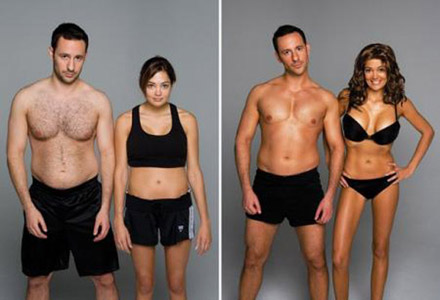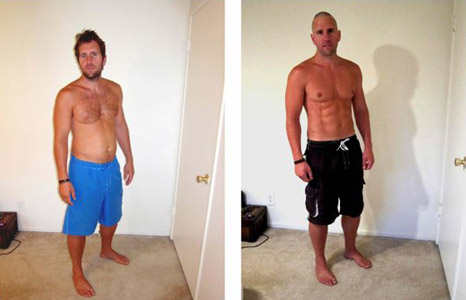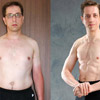DON’T BELIEVE EVERYTHING
THAT YOU SEE
You’re running late to work, so you skip breakfast. When lunch rolls around, you’re out running a few errands, so you decide to grab a double cheeseburger from the drive-thru. You’re exhausted after work, so you order takeout for dinner.
While sitting on the sofa, you watch the TV ads millions of Americans have seen for weight loss products that promise you can shed pounds by just taking a pill. And then you see one that catches you by surprise: “The Cookie Diet,” which allows you to look like the tanned, attractive celebrities you see in movies by trimming your daily intake of food and increasing the amount of cookies you eat. This is too good to be true, you think, as you pick up the phone and call to sign up. Chances are, you’re probably right.
Americans are bombarded with news stories about how obesity is linked to preventable causes of death, including stroke, heart disease, type 2 diabetes, and specific types of cancer. These stories are relevant because more than 1/3 of the American population is obese. Add this to the fact American culture is hyper-focused on image, and you have many Americans desperate to lose weight (whether they need to or not).
The quick-fix diet has become (and continues to be) very popular. At any given time, 50% of women and 25% of men are on a diet every year; that’s millions of Americans potentially putting their health at risk with fad diets, dangerous weight loss drugs, or extreme surgeries like gastric bypass.
The fact that fad diets are usually unsuccessful shouldn’t be surprising. Many studies have shown that people who yo-yo diet are more likely to gain more weight after the diet is over than if they hadn’t dieted at all. America’s instant gratification culture is prone to fad diets, repetitive dieting, and new food products.
When a new study is released that makes a certain food’s toxic properties known, or when a new product touts a specific food as the solution to everyone’s weight problems, there is usually a noticeable scramble to buy that food and try it out. After all, what’s the worst that could happen? Consequently, America’s diet preferences change from decade to decade, from the low-fat diets of the ’80s to Master Cleanse and the gluten-free diets of today.
There is no denying the potential payoff of reducing your calorie intake: Eliminating foods high in calories from your daily diet can help you lose weight. Eventually, however, the average dieter will more than likely succumb to the ice cream that’s still in the freezer or will just have “one of those days” and order takeout food. When this happens, the dieter is more likely to give up the diet than to accept the setback and continue following the rules. The prevailing thought tends to be, “Well, I’ve cheated. I might as well eat whatever I want today and start again tomorrow.”
One important fact about diets is that they aren’t just a change in what you eat; they are a change in how you think about life, how you approach food, and what situations you choose to put yourself in. Dieting is an attitude, and attitudes don’t change overnight.
Fad diets are a distraction from the real health issues America faces. The truth, however painful to accept, is that a well-balanced diet with fruits, vegetables, whole grains, low-fat dairy, and lean protein is the key to maintaining a healthy weight. Such a diet promotes heart health and helps reduce the risk of type 2 diabetes and certain types of cancer.
The American Heart Association recommends 30 minutes of physical activity every day as a key component of maintaining a healthy weight. Still, the amount of time and effort it takes to shop for fruits and vegetables and plan your meals can be significant, and not many people take pleasure in going to the gym every week. Trying out a neatly outlined fad diet is much easier than overhauling a sedentary lifestyle.
The widespread influence of the Internet and mass media has made it easier for bogus advertisers to take advantage of people who want to lose weight fast.
The widespread influence of the Internet and mass media has made it easier for bogus advertisers to take advantage of people who want to lose weight fast. Digital manipulation of photographs and clever positioning of lights can make a person look as though they’ve lost weight without trying. Even though post-editing photographs is nothing new (photographers do this with models in magazines all the time), it becomes a problem when consumers pay money for useless products or ingest weight loss chemicals that could be dangerous to their health. Don’t be fooled by weight loss products that claim to help you lose weight fast by doing absolutely nothing: Not only is this unnatural, but it’s unhealthy, and it might even come with fine print concerning negative effects on your well-being.
Education is the key to ending America’s obsession with quick-fix diets. Adults can educate themselves on the basics of nutrition, including learning how to cook simple nutritious meals, with relative ease. Many websites, magazines, and professional organizations dedicate themselves to health and nutrition and to disseminating information that can help people make healthy choices for themselves and their families.
By making their health and well-being a priority, parents can teach children how to have a healthy relationship with food. Schools also play a critical role in this nutrition education: by fueling children’s minds and bodies during school hours with an emphasis on balanced, healthy choices, the next generation can be conditioned to be conscious about their food selections. The eat-real-foods-in-healthy-portions-and-exercise-30-minutes-a-day diet might not sound as appealing as the Cookie Diet, but it certainly has better — and longer-lasting — results.






















